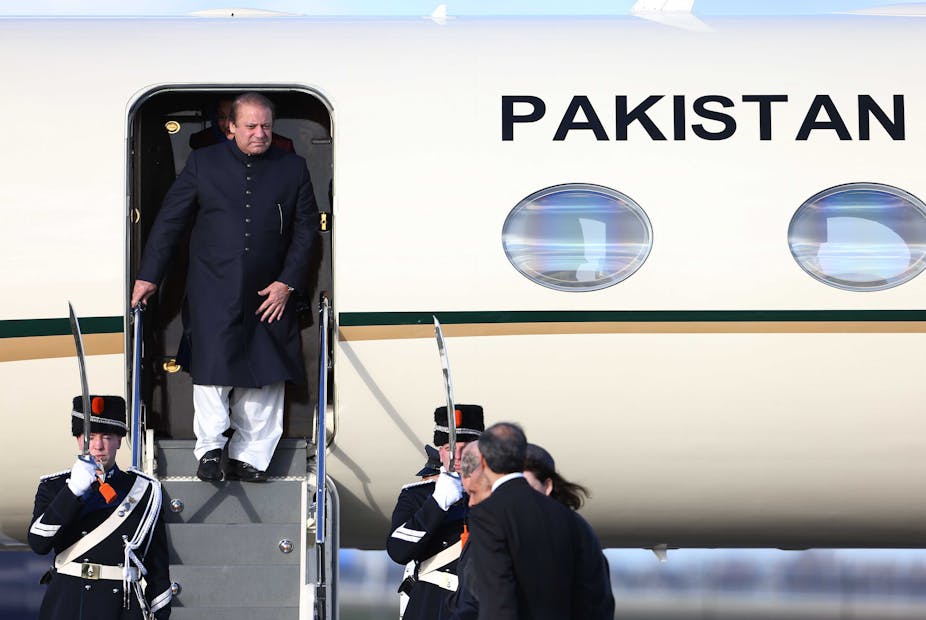Shortly after Pakistan’s May 2013 elections returned Nawaz Sharif to power, I published an article asking whether, having been twice removed from the office of prime minister with less than half his term completed, this might be a case of “third time lucky”.
In particular, I wondered if Sharif, deposed by Pervez Musharraf in a coup in 1999, might finally have learnt from the criticisms of bullying and arrogance that undermined his two previous administrations.
Based on Pakistan’s recent anti-government unrest, the signs are not good. Instead, the country’s descent into crisis has been swifter than anyone anticipated, after what was acclaimed as a “breakthrough election” in 2013.
Still, it is important to dispose of the simplistic narrative of the past 16 months, in which the military has deliberately and single-handedly engineered the undermining of Nawaz Sharif and consequently imperilled the process of democratic consolidation.
It has supposedly done this because of a series of high profile differences with the prime minister on issues such as: trade relations with India, former president Pervez Musharraf’s treason trial, peace talks with the Pakistani Taliban (TTP), and the response to Geo News’s conflict with the intelligence services (the ISI) following the shooting of talk show host Hamid Mir.
While the military is certainly a major force in Pakistan’s politics, there is much more at play here – and much can be laid at the feet of Sharif, his advisers, and his brothers.
Falling out
The peace talks with the TTP, while overly protracted, did not expose a fundamental rift between the civilian administration and the military; they really represented an effort by Sharif’s government to ensure that all parties would support military action against extremists in North Waziristan.
Musharraf had been advised not to return to Pakistan by his former associates in the security establishment. Ill-advised comments by Sharif’s ministers, as much as by the prime minister himself, stirred up military sympathy for Musharraf, and the ensuing animosity encouraged Sharif to renege on an exit strategy for Musharraf. All this chaos just increased a deep and long-standing military distrust of civilian government.
With the army now engaged in North Waziristan and with uncertainties in Afghanistan, the army’s chief of staff, Raheel Sharif (no relation) has not shown any obvious desire to end the army’s public commitment to democracy. But the army has benefited from the prime minister’s recent difficulties, which have stalled any attempt to rebalance civil/military relations. Even if he survives the current crisis, Nawaz Sharif will be severely weakened.
If not engineering the opposition parties’ struggle against the prime minister, the security establishment has done nothing to hinder it. It is unlikely that Imran Khan would have persisted with his ever-escalating demands relating to the May 2013 vote rigging allegations if the security establishment had clearly indicated its disapproval.
Still, if the army has probably not deliberately engineered the crisis as such, Sharif must surely bear some responsibility.
Same old Sharif
Throughout the course of his still-new third term, the prime minister has displayed a dangerous set of traits. His political style still entails long periods of relative inactivity punctuated by panic, and at times by brutal suppression of dissent. Overlaying these tendencies, there remains an initial arrogance of power, and excessive self-assurance.
This is what stopped Khan’s claims of vote-rigging from being nipped in the bud before the dramatic escalation in the anti-government protests.
These traits don’t just spring from Sharif’s personality; they reflect a particular political style, a toned-down version the mode of leadership he displayed during his first two terms.
There is the same reliance on a small political coterie and select bureaucrats; dissent within the party is still not tolerated, and party activists are still kept at arm’s length. There is also the familiar over-sensitivity to criticism, and the prioritisation of personal loyalty over institution-building – though this, of course, is hardly confined to Sharif’s party.
Poor performance
Largely as a result of this toxic political atmosphere, the government’s legislative record in its first year in office contrasts very unfavourably with its predecessor’s. Despite its reputation for poor governance, Asif Ali Zardari’s PPP-led coalition government secured the passage of around 100 bills, including the landmark 18th constitutional amendment, intended to curb the power of the presidency and decentralise power.
Zardari had the wily skills and consensus-building ability to lead PPP through a full term and score some real policy achievements. These leadership skills are urgently needed if Pakistan is to truly consolidate its democracy – especially since the military remains an important political player – but Sharif simply lacks the temperament and experience of consensus-building required.
That much was evident in the brutal police action in the Model Town suburb of Lahore, which left eight people dead in June. With hindsight, that action – which targeted the headquarters of Dr Tahirul Qadri’s Pakistan Awami Tehreek (PAT) – looks more and more like a major miscalculation, and one in keeping with the Sharif brothers’ resistance to any threat to their Punjab powerbase.
Finally, Sharif’s long-established political aloofness helps explain his failure to seek parliament’s support managing the crisis. Instead, it appears that parliament was misled over his ill-advised decision to turn to army mediation.
The protests may have left Sharif’s government in place for now, but they have also put his politically ruinous character flaws on display for all to see. Whatever forces are actually driving the expressions of popular outrage at his government, Sharif’s third attempt at running Pakistan is increasingly going the way of his first two.

